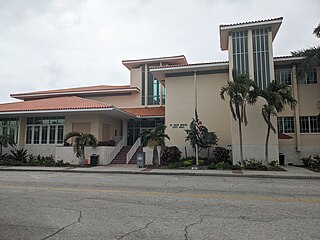
Kurt Vonnegut was an American writer and humorist known for his satirical and darkly humorous novels. In a career spanning over 50 years, he published fourteen novels, three short-story collections, five plays, and five nonfiction works; further collections have been published after his death.

St. Petersburg is a city in Pinellas County, Florida, United States. As of the 2020 census, the population was 258,308, making it the fifth-most populous city in Florida and the second-largest city in the Tampa Bay Area, after Tampa. It is the largest city in the state that is not a county seat. Along with Clearwater, these cities are part of the Tampa–St. Petersburg–Clearwater Metropolitan Statistical Area, the second-largest in Florida with a population of around 2.8 million. St. Petersburg is on the Pinellas peninsula between Tampa Bay and the Gulf of Mexico, and is connected to mainland Florida to the north.

Clearwater is a city located in Pinellas County, Florida, United States, west of Tampa and north of St. Petersburg. To the west of Clearwater lies the Gulf of Mexico and to the southeast lies Tampa Bay. As of the 2020 census, the city had a population of 117,292. Clearwater is the county seat of Pinellas County and is the smallest of the three principal cities in the Tampa–St. Petersburg–Clearwater metropolitan area, most commonly referred to as the Tampa Bay Area.

Pinellas Park is a city located in central Pinellas County, United States. The population was 53,093 at the 2020 census. The city is the fourth largest city in Pinellas County. The city was incorporated in 1914.

St. Pete Beach is a coastal city in Pinellas County, Florida. Known as a tourist destination, St. Pete Beach was formed from the towns of Pass-a-Grille, Belle Vista, St. Petersburg Beach, and unincorporated Pinellas County. It is part of the Tampa Bay area. The population was 8,879 at the 2020 census.

The Iroquois Theatre fire was a catastrophic building fire in Chicago, Illinois, that broke out on December 30, 1903 during a performance attended by 1,700 people. The fire caused 602 deaths and 250 non-fatal injuries. It ranks as the worst theater fire in the United States, surpassing the carnage of the Brooklyn Theatre fire of 1876, which claimed at least 278 lives.

The Tampa Bay Times, called the St. Petersburg Times until 2011, is an American newspaper published in St. Petersburg, Florida, United States. It is published by the Times Publishing Company, which is owned by The Poynter Institute for Media Studies, a nonprofit journalism school directly adjacent to the University of South Florida St. Petersburg campus.

California bungalow is an alternative name for the American Craftsman style of residential architecture, when it was applied to small-to-medium-sized homes rather than the large "ultimate bungalow" houses of designers like Greene and Greene. California bungalows became popular in suburban neighborhoods across the United States, and to varying extents elsewhere, from around 1910 to 1939.

The Don CeSar is a hotel located in St. Pete Beach, Florida. Developed by Thomas Rowe and opened in 1928, it gained renown as the Gulf playground for America's pampered rich at the height of the Jazz Age. The hotel was designed by Henry H. Dupont. The Don CeSar is a member of Historic Hotels of America, the official program of the National Trust for Historic Preservation.
St. Petersburg College (SPC) is a public college in St. Petersburg, Florida. It is part of the Florida College System and one of the institutions in the system designated a "state college," as it offers a greater number of bachelor's degrees than traditional community colleges focused on associate degrees. It is accredited by the Southern Association of Colleges and Schools and enrolled about 29,000 students in the fall of 2018.

The St. Petersburg Public Library is a Carnegie library built in 1915 in Beaux-Arts style. It was one of ten Florida Carnegie libraries to receive grants awarded by the Carnegie Corporation of New York from 1901 to 1917. Steel magnate and philanthropist Andrew Carnegie provided funding for more than 3,000 Carnegie libraries in the United States, Canada, and Europe. The library is significant to the city's history as the first permanent home of the public library system and embodies the transformation of the city in the second decade of the twentieth century from a pioneer village to a city with viable cultural institutions.

Tropical Storm Keith struck the Continental United States later in the calendar year than any tropical cyclone since the 1925 Atlantic hurricane season. The nineteenth tropical depression and eleventh named storm of the 1988 Atlantic hurricane season, Keith developed out of a tropical wave in the Caribbean Sea on November 17. It tracked northwestward, and under generally favorable conditions, Keith reached a peak intensity of 70 mph (110 km/h) shortly before striking the northeastern tip of the Yucatán Peninsula. It turned northeastward in the Gulf of Mexico, and made landfall near Sarasota, Florida, on November 23. Keith accelerated its forward motion under the influence of a cold front, and became extratropical near Bermuda on November 24. The extratropical remnant persisted for two more days.

The American System-Built Homes were modest houses in a series designed by architect Frank Lloyd Wright. They were developed between 1911 and 1917 to fulfill his interest in affordable housing but were sold commercially for just 14 months. The Wright archives include 973 drawings and hundreds of reference materials, the largest collection of any of single Wright project. Wright cancelled the project in July of 1917 by successfully suing his partner Arthur Richards for payments due and didn't speak of the program again. The designs were standardized, and customers could choose from one hundred and twenty nine models on seven floorpans. Because of this standardization, the lumber could be milled at a factory, thereby cutting down on both waste and the amount of skilled labor needed for construction. The buildings are often termed prefabricated homes, but they were not, since prepared materials were delivered to the work site for construction by a carpenter. Windows, doors and some cabinetry were made at the factory. Frames, shelves, trim and some fixtures were cut and assembled on site. Every milled profile had a part number and corresponding instructions and drawings for construction. Many extant homes remain in private hands and an ad hoc homeowners group sometimes meets to share ideas. Six structures are located in a federal historic district in Milwaukee, Wisconsin, and others have been designated Chicago Landmarks in Chicago, Illinois.

Carl Prinzler was the Manager of the Builders Hardware Department at the Vonnegut Hardware Company in 1903. Prinzler, along with his architect and engineer neighbor Henry H. DuPont, developed the first "panic bar" device for doors which can be opened from the inside despite being locked on the outside.

The Vonnegut Hardware Company was a Indianapolis hardware store that operated from 1852 to 1965. It was founded by Clemens Vonnegut, Sr., a German former textile ribbon salesman from Amsterdam, who arrived in Indianapolis around 1851.

John Stansel Taylor (1871-1936) was a Largo, Florida politician, citrus grower, and businessman who served as the first State Senator from Pinellas County, Florida. He was born "six miles south of Largo" on March 21, 1871, before Largo became a municipality and when Pinellas County was still Western Hillsborough County. Taylor’s parents were among the Pinellas Peninsula's first pioneers, and he was one of the first residents to be born in the Largo area. He was one of four members of his family to serve in the State Legislature. He was one of the largest landowners in Pinellas County, owning citrus groves and a packing plant at a time when Largo was nicknamed "Citrus City." Taylor was President of the Florida Citrus Exchange and a Member of the State Citrus Commission. He has been called "the father of Pinellas County." He died in 1936. Taylor Lake Park, a Pinellas County park, was named in his honor.
Shorecrest Preparatory School is a private, non-profit, non-sectarian, coeducational, college preparatory day school for students age 3 through Grade 12, located in St. Petersburg, Florida. Founded in 1923, it is the oldest independent day school in the state of Florida. A PK-12 institution, it serves St. Petersburg as well as the greater Tampa Bay area. The campus is on 28 acres located in St. Petersburg. Shorecrest hosts the school's various sport teams known as the Chargers. 100% of Shorecrest seniors are accepted to college.

This is a timeline of the U.S. state of Florida.

Francis J. Kennard was a prolific architect of many prominent buildings in Tampa, Florida. The public buildings he designed are often in the Neoclassical style. His work includes Hillsborough High School, St. Andrews Episcopal Church, and the Belleview-Biltmore Hotel. Kennard employed the French Renaissance Revival style in his design for el Centro Español de Tampa as well as influences from Moorish Revival and Spanish Mediterranean Revival.
The James Weldon Johnson Community Library is a public library located in St. Petersburg, Florida. It is a branch of the St. Petersburg Library System, which services a large area in southern Pinellas County, Florida.


















